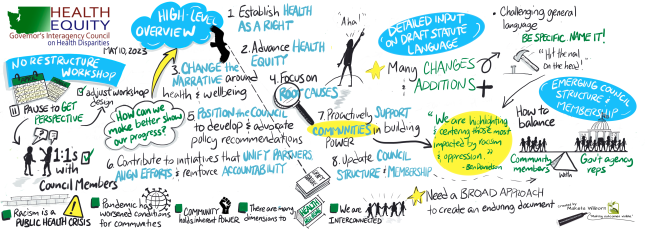Council Redesign Process
Several years ago, the Council began discussing the need to redesign our statute, the law that directs our work. We want to incorporate our many years of work and learning alongside partners and create opportunity for greater collective impact.
KEY LESSON:
The Council heard from our advisory committees and members of the public, particularly communities most impacted by inequities, that Washington needs to address structural and institutional inequities in our state system as a key strategy to eliminating health inequities.
Resources are often designed to make us feel better without changing the systems that are making us sick. Community partner
KEY LESSON:
The compass should always be community. Partners shared that the Council needs to develop goals and do work that meets community expectations, and communities must be engaged in every step of the process.
We already know what the problems are and have solutions - we just need people to listen to us. Community partner
Since November 2022, the Council has been holding a series of public redesign workshops. We have also connected with key governmental and community partners to learn how the Council can lead or support unified goals for health and wellbeing. Partners offered insight on how the Council could better engage communities as well as align with partners’ visions and priorities to address unjust health disparities (inequities) and advance health justice and equity.

These foundational truths provide shared purpose and meaning for this redesign:
- Racism is a public health crisis.
- The COVID-19 pandemic has highlighted and magnified the human cost of health inequities.
- Climate change affects us all, exacerbates inequities, and must be addressed through a racial equity and intersectional lens.
- We are interconnected.
- There are many dimensions to health and wellbeing.
- Community holds inherent power.
Even with diversity in the workforce, racism prevents equity.
Immigrants and LGBTQ communities don't have access to as many services.
Council’s Redesign Proposal
The Council’s proposal has two main components:
- Statutory: Clarify and update the Council’s focus, processes, and responsibilities by revising our authority in state law (RCW 43.20.270, 43.20.275, 43.20.280).
- Budgetary: Dedicate adequate and sustainable funding through the state budget for Council operations.
The Council’s request legislation (House Bill 2346 - Updating the governor's interagency coordinating council on health disparities) did not pass the legislature in the 2024 Legislative Session. However, the Council did receive operating funds from the legislature, which allows us to hire additional staff, build a stronger foundation, and connect with partners across the state.
For the 2025 Legislative Session, the Council has resubmitted request legislation for the Governor’s consideration and it is currently under review. Revising the Council’s statute would also require action by state lawmakers during legislative session.
Access the full proposal and more information here:
- 2025 Redesign Proposal Summary (updated January 2025)
- Health Justice and Equity Information Sheet (November 2024)
- [NEW!] Updated Draft Bill (Version z-0107.2, November 2024)
- Report: January 2024 State Action Plan Update
- Full Proposed Updates to Council Statute (October 2023)
- Report on Summer 2023 community partner engagement
- Current Council statute
“Our vision for change, our vision for Washington, our vision for health equity should be rooted in joy because ultimately, that’s a critical indicator of a good quality of life—that we can experience joy in meaningful ways.”
- Victor Rodriguez, Council Vice Chair, Community Member seat
How much more research do we need? We know what the inequities and root causes are. Ensure there is action and address the root causes instead of recycling what we already know.
Council Background: 17 Years of Work and Learning
The Governor’s Interagency Council on Health Disparities (Council) was created by the state legislature in 2006. Currently, our primary role is to identify priorities and create recommendations for the Governor and state lawmakers to eliminate health disparities by race/ethnicity and gender in Washington. Our authorizing statute (RCW 43.20.270-43.20.280), the law that governs our work, directs the Council to address certain health topics on an incremental basis along with addressing the social determinants of health.
[We're] working in solidarity so everyone has meaningful opportunity to achieve their full potential.
I have hope for more change. We saw our Latino communities left behind during the pandemic.
Since 2006, the Council has worked in partnership with state agencies and public, private, and community organizations to identify priorities, convene advisory committees, and create policy recommendations.
The Council released the first State Action Plan in 2010 and has published periodic updates since. In addition to the list of health conditions and indicators mentioned in our statute, we have created recommendations on:
- access to healthy food
- health insurance coverage
- healthcare services capacity in rural areas
- healthcare workforce diversity
- behavioral health
- reproductive health access
- environmental exposures and hazards
- educational opportunity gaps
- poverty reduction
- disaggregated data
- culturally and linguistically appropriate services
- equity in state government
- community engagement
Contact
To learn more about the Council’s work and this redesign project, contact us at healthequity@sboh.wa.gov or 360-236-4110.
